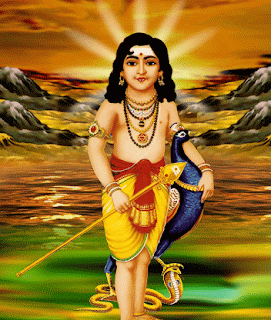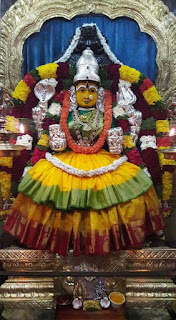Arunachalesvara Temple (also called Annamalaiyar Temple), is a Hindu temple dedicated to the deity Shiva, located at the base of Arunachala hill in the town of Thiruvannamalai in Tamil Nadu, India. It is significant to the Hindu sect of Saivism as one of the temples associated with the five elements, the Pancha Bhoota Stalas, and specifically the element of fire, or Agni.
https://en.wikipedia.org/wiki/Arunachalesvara_Temple
Shiva is worshiped as Arunachalesvara or Annamalaiyar, and is represented by the lingam, with his idol referred to as Agni lingam. His consort Parvati is depicted as Unnamalai Amman.The presiding deity is revered in the 7th century Tamil Saiva canonical work, the Tevaram, written by Tamil saint poets known as the nayanars and classified as Paadal Petra Sthalam. The 9th century Saiva saint poet Manikkavasagar composed the Tiruvempaavai here.
The temple complex covers 10 hectares, and is one of the largest in India. It houses four gateway towers known as gopurams. The tallest is the eastern tower, with 11 stories and a height of 66 metres (217 ft), making it one of the tallest temple towers in India built by sevappa nayakkar (Nayakar dynasty)[4] The temple has numerous shrines, with those of Arunachalesvara and Unnamalai Amman being the most prominent. The temple complex houses many halls; the most notable is the thousand-pillared hall built during the Vijayanagar period.
The present masonry structure was built during the Chola dynasty in the 9th century, while later expansions are attributed to Vijayanagara rulers of the Sangama Dynasty (1336–1485 CE), the Saluva Dynasty and the Tuluva Dynasty (1491–1570 CE). The temple is maintained and administered by the Hindu Religious and Charitable Endowments Department of the Government of Tamil Nadu.
https://amzn.to/3qgRsVV
The temple has six daily rituals at various times from 5:30 a.m. to 10 p.m., and twelve yearly festivals on its calendar. The Karthigai Deepam festival is celebrated during the day of the full moon between November and December, and a huge beacon is lit atop the hill. It can be seen from miles around, and symbolizes the Shiva lingam of fire joining the sky.The event is witnessed by three million pilgrims. On the day preceding each full moon, pilgrims circumnavigate the temple base and the Arunachala hills in a worship called Girivalam, a practice carried out by one million pilgrims yearly.
https://en.wikipedia.org/wiki/Tiruvannamalai
https://en.wikipedia.org/wiki/Karthika_Deepam
Katyayani (कात्यायनी) is one of the main forms of The Hindu Mother Goddess, Devi. She is seen as the slayer of the tyrannical demon Mahishasura. She is also the sixth form amongst Navadurga or the nine forms of Hindu goddess Durga (Parvati), worshipped during the Navratri celebrations.
She may be depicted with four, ten, or eighteen hands. This is the second name given for Goddess Adi Parashakti in Amarakosha, the Sanskrit lexicon (Goddess Parvati names- Uma Katyayani Gauri Kali Haimavati Ishwari). Goddess Katyayani was worshipped by Sita, Radha and Rukmini for a good husband.
In Shaktism she is associated with the fierce forms of Shakti or Durga, a Warrior goddess, which also includes Bhadrakali and Chandika, and traditionally she is associated with the colour red, as with Goddess Parvati, the primordial form of Shakti, a fact also mentioned in Patanjali's Mahabhashya on Pāṇini, written in 2nd century BCE.
She is first mentioned in the Taittiriya Aranyaka part of the Yajurveda. Skanda Purana mentions her being created out of the spontaneous anger of Gods, which eventually led to slaying the demon, Mahishasura, mounted on the lion. This occasion is celebrated during the annual Durga Puja festival in most parts of India.
https://amzn.to/3qeJn4a
Her exploits are described in the Devi-Bhagavata Purana and Devi Mahatmyam, part of the Markandeya Purana attributed to sage Markandeya Rishi, who wrote it in Sanskrit ca. 400-500 CE. Over a period of time, her presence was also felt in Buddhist and Jain texts and several Tantric text, especially the Kalika-Purana(10th century), which mentions Uddiyana or Odradesa (Odisha), as the seat of Goddess Katyayani and Lord Jagannath.
In Hindu traditions like Yoga and Tantra, she is ascribed to the sixth Ajna Chakra or the Third eye chakra and her blessings are invoked by concentrating on this point.
Karthigai Deepam Festival is celebrated in all parts of Tamil Nadu. The Festival of Lamps, Karthigai symbolizes the eradication of ignorance and lighting up intelligence in mankind. Temples and houses wear a festive look during this festival. Sweets, delicacies and crackers make the festival more wonderful. There are many Temples To Visit In Tamilnadu During Karthigai Deepam Festival to celebrate it in a grand manner. Kanchipuram Ekambareswarar Temple, Madurai Meenakshi Amman Temple are some of the notable and famous temples to visit during Karthigai Deepam, where the spectacular arrangements of lights can be enjoyed.
https://en.wikipedia.org/wiki/KartikeyaKartikeya is known by numerous names in ancient and medieval texts of the Indian culture. Most common among these are Murugan, Kumara, Skanda, and Subrahmanya. Others include Aaiyyan, Cheyyon, Senthil, Vēlaṇ, Swaminatha ("ruler of the gods", from -natha king), śaravaṇabhava ("born amongst the reeds"), Arumugam or ṣaṇmukha ("six-faced"), Dandapani ("wielder of the mace", from -pani hand), Guha (cave, secret) or Guruguha (cave-teacher), Kadhirvelan, Kandhan, Vishakha and Mahasena.
In ancient coins where the inscription has survived along with his images, his names appear as Kumara, Brahmanya or Brahmanyadeva. On some ancient Indo-Scythian coins, his names appear in Greek script as Skanda, Kumara and Vishaka. In ancient statues, he appears as Mahasena, Skanda and Vishakha.
Skanda is derived from skanḍr-, which means "leaper or attacker".
https://en.wikipedia.org/wiki/Skanda_Purana
In Kalidasa’s epic poem Kumarasambhava (“The Birth of the War God”; 5th century CE), as in most versions of the story, the gods wished for Skanda to be born in order to destroy the demon Taraka, who had been granted a boon that he could be killed only by a son of Shiva. They sent Parvati to induce Shiva to marry her. Shiva, however, was lost in meditation and was not attracted to Parvati until he was struck by an arrow from the bow of Kama, the god of love, whom he immediately burned to ashes. After many years of abstinence, Shiva’s seed was so strong that the gods, fearing the result, sent Agni, the god of fire, to interrupt Shiva’s amorous play with Parvati. Agni received the seed and dropped it into the Ganges, where Skanda was born.
Kartikeya means "of the Krittikas". This epithet is also linked to his birth. After he appears on the banks of the River Ganges, he is seen by the six of the seven brightest stars cluster in the night sky called Krittikas in Hindu texts (called Pleiades in Greek texts). These six mothers all want to take care of him and nurse baby Kartikeya. Kartikeya ends the argument by growing five more heads to have a total of six heads so he can look at all six mothers, and let them each nurse one. The six Krittikas are Śiva, Sambhūti, Prīti, Sannati, Anasūya and Kṣamā.
https://en.wikipedia.org/wiki/Thiruparankundram_Murugan_temple
https://en.wikipedia.org/wiki/Karthika_Deepam
https://en.wikipedia.org/wiki/K%E1%B9%9Bttik%C4%81
https://amzn.to/3nNlNtS
Many legends and lyrical poetry have grown around this star. The six stars are considered in Indian mythology as the six celestial nymphs who reared the six babies in the Saravana tank which later were joined together to form the six faced Muruga. They are Dula, Nitatni, Abhrayanti, Varshayanti, Meghayanti and Chipunika. He is therefore called Karthikeya, the incarnation of Lord Shiva as his second son after Lord Ganesha.
https://amzn.to/2XClWp7
It is believed that Lord Shiva created Muruga from his 3rd eye of six primary faces (Tatpurusam, Aghoram, Sadyojatam, Vamadevam, Eesanam, Adhomukam ). It is believed that the six forms made into six children and each of them brought up by the six Karthigai nymphs (Śiva, Sambhūti, Prīti, Sannati, Anasūya and Kṣamā ) and later merged into one by his mother Parvati.
While merging he also formed into a six faced (Arumugam and twelve handed god. The Lord Murugan is also portrayed with his six plays and worshiped with six names.
As the six nymphs helped in growing the child, Lord Shiva blessed immortality to the six nymphs as ever living stars on the sky. Any worship performed to this six stars is equal to worshiping Lord Muruga himself. They are worshiped by lighting up rows of oil lamps (Deepam) in the evening of the festival day around the houses and streets. Karthikai Deepam is also known as Kartikeya, or Muruga's birthday.
Other Mythological Stories and Literature on this 6 stars Pleiades in folklore and literature or Kṛttikā.




।। महिषासुरमर्दिनिस्तोत्रम् ॥
EXACT MURTI OF DEVI MA WITH MINUTEST DETAIL AS DESCRIBED IN ANCIENT TEXTS.
अयि गिरिनंदिनि नंदितमेदिनि विश्वविनोदिनि नंदनुते
गिरिवरविंध्यशिरोधिनिवासिनि विष्णुविलासिनि जिष्णुनुते।
भगवति हे शितिकण्ठकुटुंबिनि भूरिकुटुंबिनि भूरिकृते
जय जय हे महिषासुरमर्दिनि रम्यकपर्दिनि शैलसुते॥१॥
सुरवरवर्षिणि दुर्धरधर्षिणि दुर्मुखमर्षिणि हर्षरते
त्रिभुवनपोषिणि शंकरतोषिणि किल्बिषमोषिणि घोषरते।
दनुजनिरोषिणि दितिसुतरोषिणि दुर्मदशोषिणि सिन्धुसुते
जय जय हे महिषासुरमर्दिनि रम्यकपर्दिनि शैलसुते॥२॥
अयि जगदंब मदंब कदंबवनप्रियवासिनि हासरते
शिखरिशिरोमणितुंगहिमालयशृंगनिजालयमध्यगते।
मधुमधुरे मधुकैटभगंजिनि कैटभभंजिनि रासरते
जय जय हे महिषासुरमर्दिनि रम्यकपर्दिनि शैलसुते॥३॥
अयि शतखण्डविखण्डितरुण्डवितुण्डितशुण्डगजाधिपते
रिपुगजगण्डविदारणचण्डपराक्रमशुण्ड मृगाधिपते।
निजभुजदण्डनिपातितखण्डनिपातितमण्डभटाधिपते
जय जय हे महिषासुरमर्दिनि रम्यकपर्दिनि शैलसुते॥४॥
अयि रणदुर्मदशत्रुवधोदितदुर्धरनिर्जरशक्तिभृते
चतुरविचारधुरीणमहाशिवदूतकृतप्रमथाधिपते।
दुरितदुरीहदुराशयदुर्मतिदानवदूतकृतांतमते
जय जय हे महिषासुरमर्दिनि रम्यकपर्दिनि शैलसुते॥५॥
अयि शरणागतवैरिवधूवरवीरवराभयदायकरे
त्रिभुवनमस्तकशूलविरोधिशिरोधिकृतामलशूलकरे।
दुमिदुमितामरदुंदुभिनादमहोमुखरीकृततिग्मकरे
जय जय हे महिषासुरमर्दिनि रम्यकपर्दिनि शैलसुते॥६॥
अयि निजहुँकृतिमात्रनिराकृतधूम्रविलोचनधूम्रशते
समरविशोषितशोणितबीजसमुद्भवशोणितबीजलते।
शिवशिव शुंभनिशुंभमहाहवतर्पितभूतपिशाचरते
जय जय हे महिषासुरमर्दिनि रम्यकपर्दिनि शैलसुते॥७॥
धनुरनुसंगरणक्षणसंगपरिस्फुरदंगनटत्कबके
कनकपिशंगपृषत्कनिषंगरसद्भटशृंगहतावटुके।
कृतचतुरंगबलक्षितिरंगघटद्बहुरंगरटद्बटुके
जय जय हे महिषासुरमर्दिनि रम्यकपर्दिनि शैलसुते॥८॥
सुरललनाततथेयितथेयितथाभिनयोत्तरनृत्यरते
हासविलासहुलासमयि प्रणतार्तजनेऽमितप्रेमभरे।
धिमिकिटधिक्कटधिकटधिमिध्वनिघोरमृदंगनिनादरते
जय जय हे महिषासुरमर्दिनि रम्यकपर्दिनि शैलसुते॥९॥
जय जय जप्यजये जयशब्दपरस्तुतितत्परविश्वनुते
झणझणझिंजिमिझिंकृतनूपुरसिंजितमोहितभूतपते।
नटितनटार्धनटीनटनायकनाटितनाट्यसुगानरते
जय जय हे महिषासुरमर्दिनि रम्यकपर्दिनि शैलसुते॥१०॥
अयि सुमनःसुमनः सुमनः सुमनः सुमनोहरकांतियुते
श्रितरजनीरजनीरजनीरजनीरजनीकरवक्त्रवृते।
सुनयनविभ्रमरभ्रमरभ्रमरभ्रमरभ्रमराधिपते
जय जय हे महिषासुरमर्दिनि रम्यकपर्दिनि शैलसुते॥११॥
सहितमहाहवमल्लमतल्लिकमल्लितरल्लकमल्लरते
विरचितवल्लिकपल्लिकमल्लिकझिल्लिकभिल्लिकवर्गवृते।
सितकृतफुल्लिसमुल्लसितारुणतल्लजपल्लवसल्ललिते
जय जय हे महिषासुरमर्दिनि रम्यकपर्दिनि शैलसुते॥१२॥
अविरलगण्डगलन्मदमेदुरमत्तमतंगजराजपते
त्रिभुवनभूषणभूतकलानिधिरूपपयोनिधिराजसुते।
अयि सुदती जनलालसमानसमोहनमन्मथराजसुते
जय जय हे महिषासुरमर्दिनि रम्यकपर्दिनि शैलसुते॥१३॥
कमलदलामलकोमलकांतिकलाकलितामलभाललते
सकलविलासकलानिलयक्रमकेलिचलत्कलहंसकुले।
अलिकुलसंकुलकुवलयमण्डलमौलिमिलद्भकुलालिकुले
जय जय हे महिषासुरमर्दिनि रम्यकपर्दिनि शैलसुते॥१४॥
करमुरलीरववीजितकूजितलज्जितकोकिलमंजुमते
मिलितपुलिन्दमनोहरगुंजितरंजितशैलनिकुंजगते।
निजगुणभूतमहाशबरीगणसद्गुणसंभृतकेलितले
जय जय हे महिषासुरमर्दिनि रम्यकपर्दिनि शैलसुते॥१५॥
कटितटपीतदुकूलविचित्रमयूखतिरस्कृतचंद्ररुचे
प्रणतसुरासुरमौलिमणिस्फुरदंशुलसन्नखचंद्ररुचे।
जितकनकाचलमौलिपदोर्जितनिर्झरकुंजरकुंभकुचे
जय जय हे महिषासुरमर्दिनि रम्यकपर्दिनि शैलसुते॥१६॥
विजितसहस्रकरैकसहस्रकरैकसहस्रकरैकनुते
कृतसुरतारकसंगरतारकसंगरतारकसूनुसुते।
सुरथसमाधिसमानसमाधिसमाधिसमाधिसुजातरते
जय जय हे महिषासुरमर्दिनि रम्यकपर्दिनि शैलसुते॥१७॥
पदकमलं करुणानिलये वरिवस्यति योऽनुदिनं स शिवे
अयि कमले कमलानिलये कमलानिलयः स कथं न भवेत्।
तव पदमेव परंपदमेवमनुशीलयतो मम किं न शिवे
जय जय हे महिषासुरमर्दिनि रम्यकपर्दिनि शैलसुते॥१८॥
कनकलसत्कलसिन्धुजलैरनुसिंचिनुते गुण रंगभुवं
भजति स किं न शचीकुचकुंभतटीपरिरंभसुखानुभवम्।
तव चरणं शरणं करवाणि नतामरवाणिनिवासि शिवं
जय जय हे महिषासुरमर्दिनि रम्यकपर्दिनि शैलसुते॥१९॥
तव विमलेन्दुकुलं वदनेन्दुमलं सकलं ननु कूलयते
किमु पुरुहूतपुरीन्दुमुखीसुमुखीभिरसौ विमुखीक्रियते।
मम तु मतं शिवनामधने भवती कृपया किमुत क्रियते
जय जय हे महिषासुरमर्दिनि रम्यकपर्दिनि शैलसुते॥२०॥
अयि मयि दीनदयालुतया कृपयैव त्वया भवितव्यमुमे
अयि जगतो जननी कृपयासि यथासि तथाऽनुमितासि रते।
यदुचितमत्र भवत्युररीकुरुतादुरुतापमपाकुरुते
जय जय हे महिषासुरमर्दिनि रम्यकपर्दिनि शैलसुते॥२१॥


























































